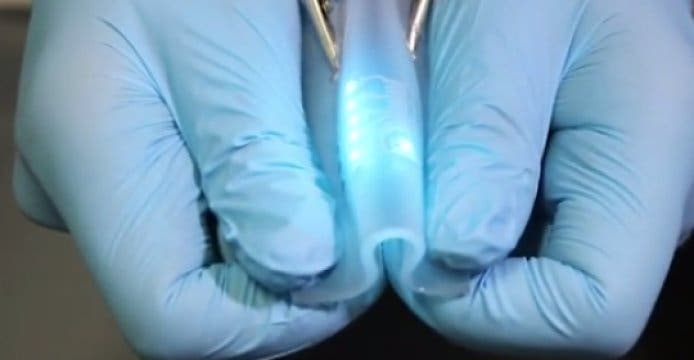Elastic circuits that can bend and stretch are here — and they mean business.

Image credits Tang et al., 2018, iScience.
Chinese researchers have developed a novel hybrid material — part elastic polymer, part liquid metal — that can bend, stretch, and still work as an electric circuit. The material can be cast in most two-dimensional shapes and, based on the polymer used, can be completely non-toxic.
Circuits, with a twist
“These are the first flexible electronics that are at once highly conductive and stretchable, fully biocompatible, and able to be fabricated conveniently across size scales with micro-feature precision,” says senior author Xingyu Jiang.
“We believe that they will have broad applications for both wearable electronics and implantable devices.”
The material the team developed is known as a metal-polymer conductor (MPC). As the name suggests, it’s a combination of two components. The metal bit of the mix carries electric charges — handling the ‘circuit’ part. However, the team didn’t use materials commonly seen in circuits, such as copper, silver, or gold, but settled on gallium and indium. These two metals form a thick fluid that’s a good electric conductor — meaning the circuits can ‘flow’ and still function while accommodating any stretching. The second component is a silicone-based polymer. This imparts mechanical resilience to the circuit, keeping the fluid ‘wires’ all neat and orderly.
Jiang’s team found that embedding globs of this gallium-indium mixture into the polymer substrate created a mechanically-strong material that can function as a circuit. Close-up, the MPC looks like a collection of metal islands in a sea of polymer. A liquid metal mantle runs underneath these islands to ensure conductivity is maintained at all times.
The team successfully trialed different MPC formulations in a wide range of applications — from sensors in wearable keyboard gloves to electrodes embedded in cells. There’s a huge range of applications these MPCs can be used for, they note, limited only by their particular polymer substrate.
“We cast super-elastic polymers to make MPCs for stretchable circuits. We use biocompatible and biodegradable polymers when we want MPCs for implantable devices,” says first author Lixue Tang.
“In the future, we could even build soft robots by combining electroactive polymers.”
The team is also confident that the MPC manufacturing method they developed — it involves screen printing and microfluidic patterning — can be used to produce any two-dimensional geometry. It can also handle different thicknesses and electric properties — which are a function of metal concentration in the circuits. This versatility could allow researchers to rapidly develop flexible circuits for a wide range of uses, the team notes, from wearable tech to bioimplants.
“We wanted to develop biocompatible materials that could be used to build wearable or implantable devices for diagnosing and treating disease without compromising quality of life, and we believe that this is a first step toward changing the way that cardiovascular diseases and other afflictions are managed,” says Jiang.
The paper “Printable Metal-Polymer Conductors for Highly Stretchable Bio-Devices” has been published in the journal iScience.
Was this helpful?



